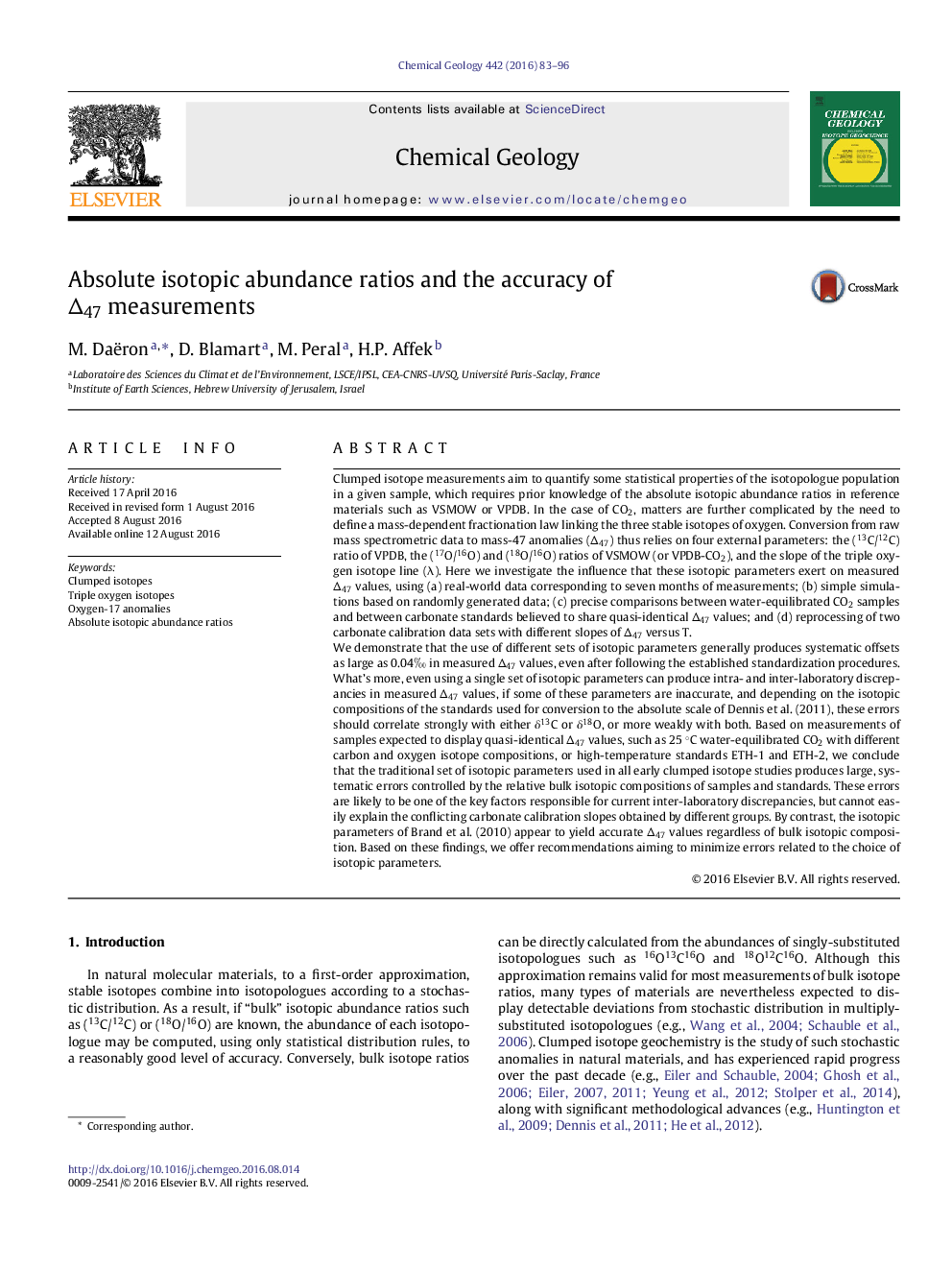| کد مقاله | کد نشریه | سال انتشار | مقاله انگلیسی | نسخه تمام متن |
|---|---|---|---|---|
| 4698190 | 1637532 | 2016 | 14 صفحه PDF | دانلود رایگان |

• Measured Δ47 values are a function of absolute 13C/12C, 17O/16O and 18O/16O ratios.
• Using different isotopic parameters produces systematic Δ47 offsets (up to 0.04‰).
• These offsets are not canceled out by current standardization procedures.
• Inaccurate parameters may partly explain current inter-laboratory discrepancies.
• Isotopic parameters of Brand et al. (2010) appear to yield accurate Δ47 values.
Clumped isotope measurements aim to quantify some statistical properties of the isotopologue population in a given sample, which requires prior knowledge of the absolute isotopic abundance ratios in reference materials such as VSMOW or VPDB. In the case of CO2, matters are further complicated by the need to define a mass-dependent fractionation law linking the three stable isotopes of oxygen. Conversion from raw mass spectrometric data to mass-47 anomalies (Δ47) thus relies on four external parameters: the (13C/12C) ratio of VPDB, the (17O/16O) and (18O/16O) ratios of VSMOW (or VPDB-CO2), and the slope of the triple oxygen isotope line (λ). Here we investigate the influence that these isotopic parameters exert on measured Δ47 values, using (a) real-world data corresponding to seven months of measurements; (b) simple simulations based on randomly generated data; (c) precise comparisons between water-equilibrated CO2 samples and between carbonate standards believed to share quasi-identical Δ47 values; and (d) reprocessing of two carbonate calibration data sets with different slopes of Δ47 versus T.We demonstrate that the use of different sets of isotopic parameters generally produces systematic offsets as large as 0.04‰ in measured Δ47 values, even after following the established standardization procedures. What's more, even using a single set of isotopic parameters can produce intra- and inter-laboratory discrepancies in measured Δ47 values, if some of these parameters are inaccurate, and depending on the isotopic compositions of the standards used for conversion to the absolute scale of Dennis et al. (2011), these errors should correlate strongly with either δ13C or δ18O, or more weakly with both. Based on measurements of samples expected to display quasi-identical Δ47 values, such as 25 °C water-equilibrated CO2 with different carbon and oxygen isotope compositions, or high-temperature standards ETH-1 and ETH-2, we conclude that the traditional set of isotopic parameters used in all early clumped isotope studies produces large, systematic errors controlled by the relative bulk isotopic compositions of samples and standards. These errors are likely to be one of the key factors responsible for current inter-laboratory discrepancies, but cannot easily explain the conflicting carbonate calibration slopes obtained by different groups. By contrast, the isotopic parameters of Brand et al. (2010) appear to yield accurate Δ47 values regardless of bulk isotopic composition. Based on these findings, we offer recommendations aiming to minimize errors related to the choice of isotopic parameters.
Journal: Chemical Geology - Volume 442, 28 November 2016, Pages 83–96